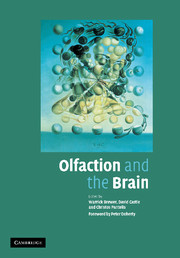Book contents
- Frontmatter
- Contents
- Foreword
- Preface
- List of Contributors
- Section I Neurology, Neurophysiology and Neuropsychology: Olfactory Clues to Brain Development and Disorder
- Section II Social Functioning: Role of Evolution, Genetics and Gender
- Section III Assessment and Disorders of Olfaction
- 13 Assessment of Olfaction
- 14 Olfactory Impairment in Neuropsychiatric Disorders
- 15 Olfaction in Parkinsonian Syndromes
- 16 Olfaction in Psychosis
- 17 Olfactory Hallucinations
- 18 Delusions of Body Malodour: The Olfactory Reference Syndrome
- Index
- Plate section
- References
16 - Olfaction in Psychosis
from Section III - Assessment and Disorders of Olfaction
Published online by Cambridge University Press: 17 August 2009
- Frontmatter
- Contents
- Foreword
- Preface
- List of Contributors
- Section I Neurology, Neurophysiology and Neuropsychology: Olfactory Clues to Brain Development and Disorder
- Section II Social Functioning: Role of Evolution, Genetics and Gender
- Section III Assessment and Disorders of Olfaction
- 13 Assessment of Olfaction
- 14 Olfactory Impairment in Neuropsychiatric Disorders
- 15 Olfaction in Parkinsonian Syndromes
- 16 Olfaction in Psychosis
- 17 Olfactory Hallucinations
- 18 Delusions of Body Malodour: The Olfactory Reference Syndrome
- Index
- Plate section
- References
Summary
Introduction
Neuropsychological, structural and functional imaging studies converge in finding that patients with schizophrenia have selective impairments in the areas of memory, attention and executive function, and have neuroanatomic and physiologic abnormalities in the temporal and frontal lobe areas underlying these cognitive domains (Saykin et al., 1991; 1994; Turetsky et al., 1995). Efforts to precisely characterise these fronto-temporal deficits and their clinical correlates have employed a variety of methods and an array of neurobehavioural probes, including physiological assessments of declarative memory, working memory, executive function and vigilance (Berman et al., 1986; Bernstein et al., 1990; Calev, 1984; Weinberger et al., 1992). Little use has been made of olfactory probes, despite the fact that these may be ideal tools to assess limbic pathophysiology.
As outlined in Chapter 1, the olfactory system is unique among the sensory modalities, in that it does not utilise the thalamus as a central relay station (Price, 1987). Primary olfactory neurons arising in the nasal epithelium project unmyelinated afferent fibres through the cribriform plate into the brain cavity, where they terminate on mitral and tufted cells whose dendrites are clustered in glomeruli in the ipsilateral olfactory bulb (OB). Axons from these second order OB neurons form the olfactory tracts, which project directly to the ipsilateral pyriform and entorhinal cortices, the ventral striatum and the ventromedial hypothalamus, with essentially no crossover to the contralateral hemisphere (Eslinger et al., 1982).
Keywords
- Type
- Chapter
- Information
- Olfaction and the Brain , pp. 296 - 321Publisher: Cambridge University PressPrint publication year: 2006

